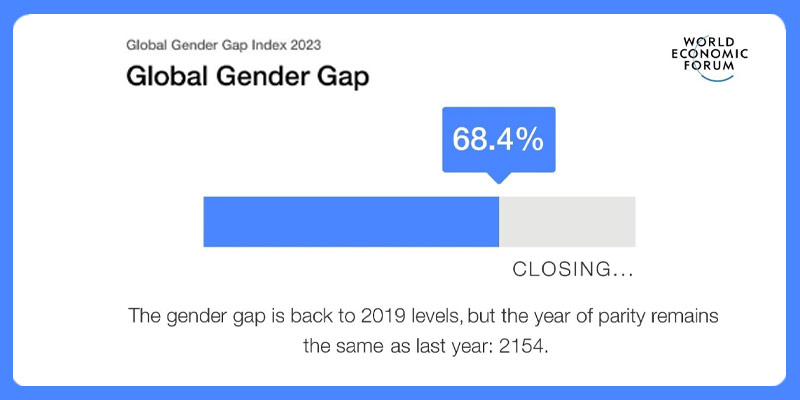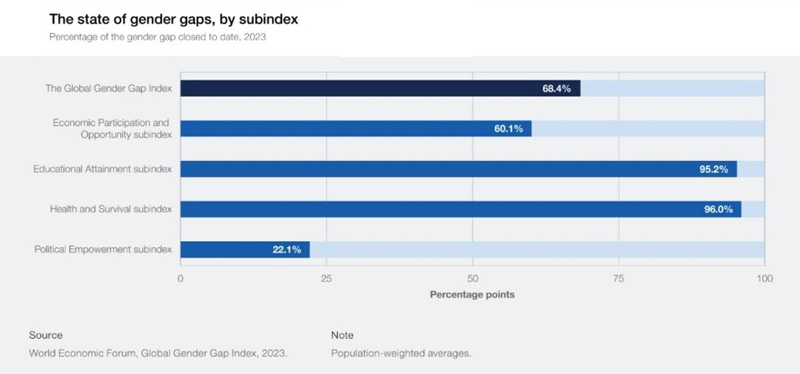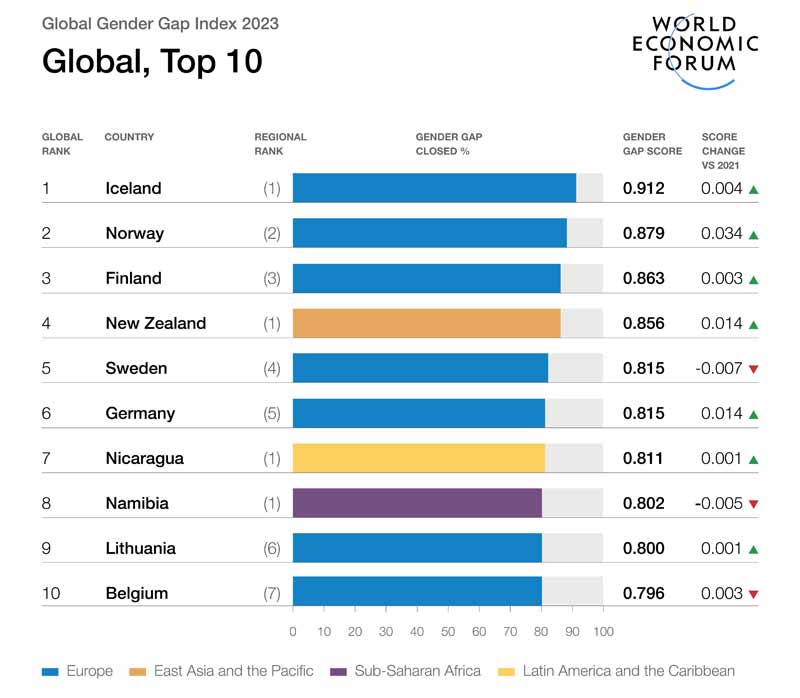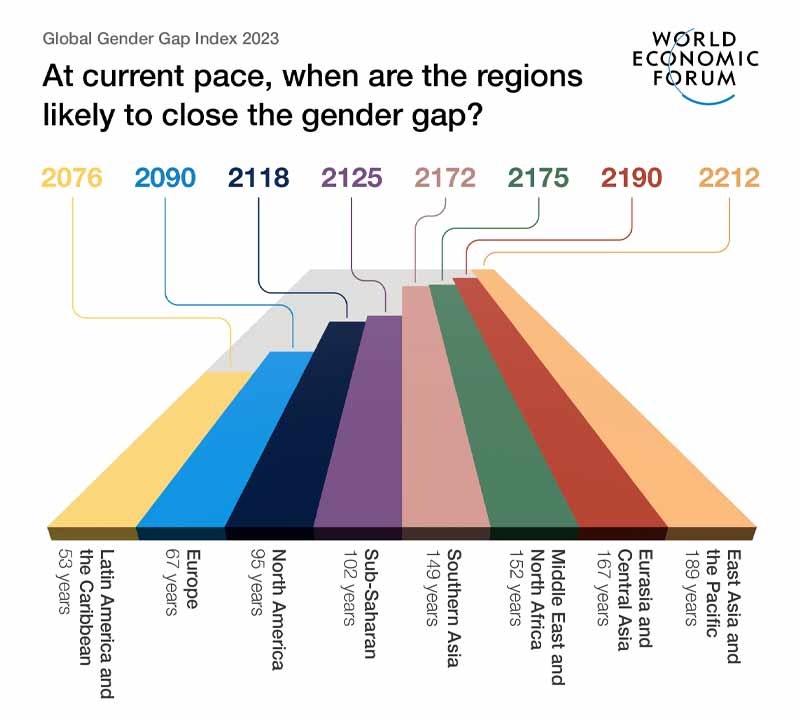- World
- Jun 22
Global gender gap could take 131 years to close
• At current rates of progress, it will take 131 years to close the global gender gap, according to the World Economic Forum’s Global Gender Gap Report 2023. However, some countries are much closer to achieving gender parity than others.
• Iceland maintains its place at the top of the global ranking – for the 14th consecutive year – with more than 90 per cent parity, followed by Norway (87.9 per cent) up one place from 2022, and Finland (86.3 per cent) drops one place to third.
• India is ranked at 127 out of 146 countries in terms of gender parity. Last year, the WEF ranked India at 135 out of 146 countries. India has improved by 1.4 percentage points and eight positions since the last edition, marking a partial recovery towards its 2020 parity level. The country has attained parity in enrolment across all levels of education.
What is the Global Gender Gap Index?
• The Global Gender Gap Index annually benchmarks the current state and evolution of gender parity across four key dimensions.
They are:
i) Economic Participation and Opportunity
ii) Educational Attainment
iii) Health and Survival
iv) Political Empowerment.
• It is the longest-standing index tracking the progress of numerous countries’ efforts towards closing these gaps over time, since its inception in 2006.
• This year, the 17th edition of the Global Gender Gap Index benchmarks gender parity across 146 countries, providing a basis for robust cross-country analysis. Further, examining a subset of 102 countries that have been included in every edition of the index since 2006 provides a large constant sample for time-series analysis.
• The Global Gender Gap Index measures scores on a 0 to 100 scale and scores can be interpreted as the distance covered towards parity, that is the percentage of the gender gap that has been closed.
• Cross-country comparisons support the identification of the most effective policies to close gender gaps.
Key findings
• The global gender gap score in 2023 for all 146 countries included in this edition stands at 68.4 per cent closed.
• At the current rate of progress, it will take 131 years to reach full parity.
• No country has yet achieved full gender parity, although the top nine countries (Iceland, Norway, Finland, New Zealand, Sweden, Germany, Nicaragua, Namibia and Lithuania) have closed at least 80 per cent of their gap.
• Iceland continues to be the only country to have closed more than 90 per cent of its gender gap.
• For the 146 countries covered in the 2023 index, the Health and Survival gender gap has closed by 96 per cent, the Educational Attainment gap by 95.2 per cent, Economic Participation and Opportunity gap by 60.1 per cent, and Political Empowerment gap by 22.1 per cent.
Evolving gender gaps in the global labour market
• The state of gender parity in the labour market remains a major challenge. Not only has women’s participation in the labour market globally slipped in recent years, but other markers of economic opportunity have been showing substantive disparities between women and men.
• While women have (re-)entered the labour force at higher rates than men globally, leading to a small recovery in gender parity in the labour-force participation rate since the 2022 edition, gaps remain wide overall and are apparent in several specific dimensions.
• Science, technology, engineering and mathematics (STEM) occupations are an important set of jobs that are well remunerated and expected to grow in significance and scope in the future. However, data show that women remain significantly underrepresented in the STEM workforce.
• Online learning offers flexibility, accessibility and customisation, enabling learners to acquire knowledge in a manner that suits their specific needs and circumstances. However, women and men currently do not have equal opportunties and access to these online platforms, given the persistent digital divide.
Gender gaps in political leadership
• Much like in the case of representation of women in business leadership, gender gaps in political leadership continue to persist. Although there has been an increase in the number of women holding political decision-making posts worldwide, achieving gender parity remains a distant goal and regional disparities are significant.
• As of December 31, 2022, approximately 27.9 per cent of the global population, equivalent to 2.12 billion people, live in countries with a female head of state. While this indicator experienced stagnation between 2013 and 2021, 2022 witnessed a significant increase.
• Another recent positive trend is observed for the share of women in parliaments. In 2013, only 18.7 per cent of Parliament members globally were women among the 76 countries with consistent data. By 2022, this number had risen steadily to 22.9 per cent.
• Significant strides have also been made in terms of women’s representation in local government globally. Out of the 117 countries with available data since 2017, as many as 18 countries, including Bolivia (50.4 per cent), India (44.4 per cent) and France (42.3 per cent), have achieved representation of women of over 40 per cent in local governance.
Scenario in India
• India has closed 64.3 per cent of the overall gender gap, ranking 127th on the global index.
• It has improved by 1.4 percentage points and eight positions since the last edition, marking a partial recovery towards its 2020 (66.8 per cent) parity level.
• The country has attained parity in enrolment across all levels of education.
• However, it has reached only 36.7 per cent parity on Economic Participation and Opportunity.
• On one hand, there are upticks in parity in wages and income. On the other hand, the shares of women in senior positions and technical roles have dropped slightly since the last edition.
• On Political Empowerment, India has registered 25.3 per cent parity, with women representing 15.1 per cent of parliamentarians, the highest for India since the inaugural 2006 edition.
• On the Health and Survival index (95 per cent), the improvement in sex ratio at birth by 1.9 percentage points to 92.7 per cent has driven up parity after more than a decade of slow progress.
• The index ranked India’s neighbours Pakistan at 142, Bangladesh at 59, China at 107, Nepal at 116, Sri Lanka at 115 and Bhutan at 103.
Gender parity initiatives solidifying
• Increasing women’s economic participation and achieving gender parity in leadership, in both business and government, are two key levers for addressing broader gender gaps in households, societies and economies.
• Collective, coordinated and bold action by private and public-sector leaders will be instrumental in accelerating progress towards gender parity and igniting renewed growth and greater resilience.
• Recent years have seen major setbacks and the state of gender parity still varies widely by company, industry and economy. Yet, a growing number of actors have recognised the importance and urgency of taking action, and evidence on effective gender parity initiatives is solidifying.
Manorama Yearbook app is now available on Google Play Store and iOS App Store




